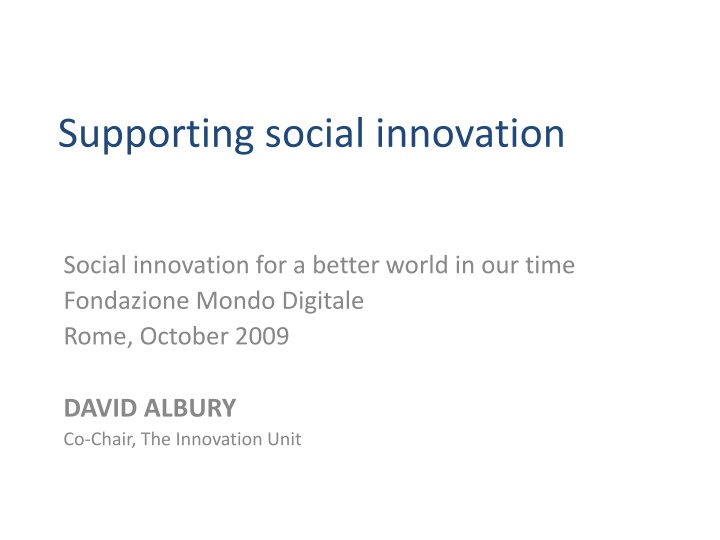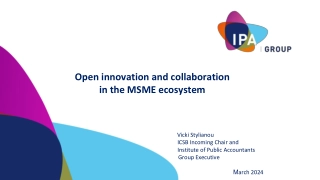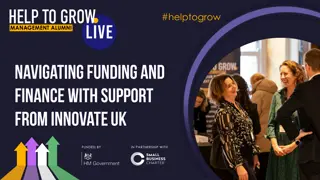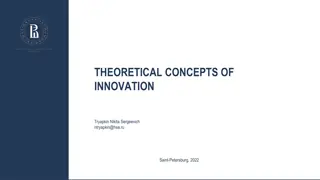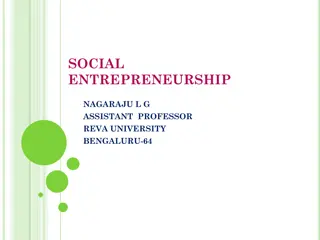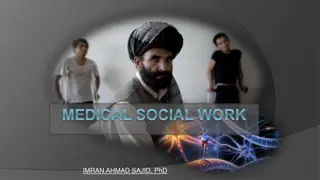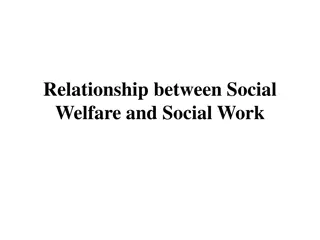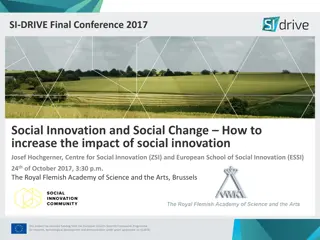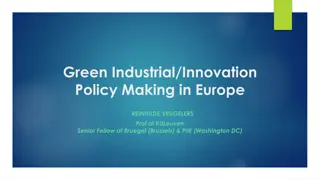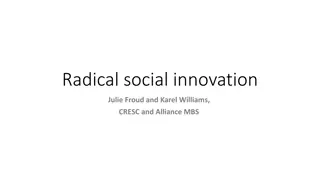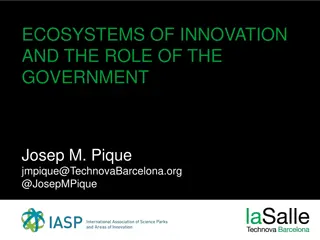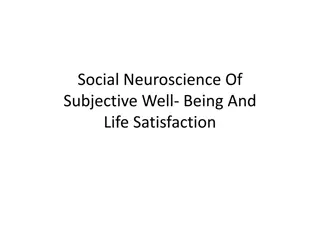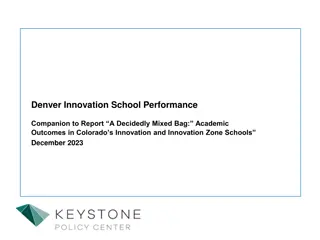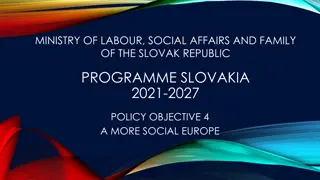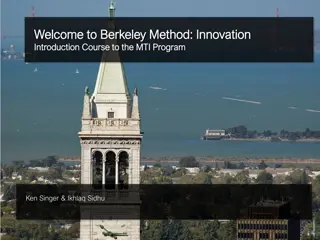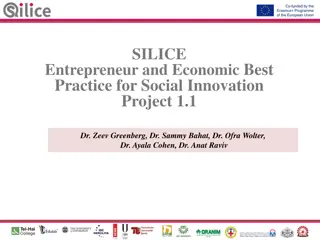Supporting Social Innovation for a Better World
In a time of increasing challenges, social innovation emerges as a powerful force for change. David Albury discusses the urgent need for radical social innovation in various sectors like education and health, highlighting the pressing issues and opportunities for transformative solutions. The dynamics of social innovation, its drivers, and sources of radical change are explored in depth, emphasizing the importance of creating conditions that foster innovation and address persistent societal issues.
Uploaded on Feb 28, 2025 | 0 Views
Download Presentation

Please find below an Image/Link to download the presentation.
The content on the website is provided AS IS for your information and personal use only. It may not be sold, licensed, or shared on other websites without obtaining consent from the author.If you encounter any issues during the download, it is possible that the publisher has removed the file from their server.
You are allowed to download the files provided on this website for personal or commercial use, subject to the condition that they are used lawfully. All files are the property of their respective owners.
The content on the website is provided AS IS for your information and personal use only. It may not be sold, licensed, or shared on other websites without obtaining consent from the author.
E N D
Presentation Transcript
Supporting social innovation Social innovation for a better world in our time Fondazione Mondo Digitale Rome, October 2009 DAVID ALBURY Co-Chair, The Innovation Unit
Why social innovation? Supporting social innovators Creating the conditions for social innovation davidalbury@btinternet.com
A perfect storm Long-term challenges which are becoming more pressing Increasing pressures and demands on services Radical and compelling social innovation: significantly better outcomes, for significantly lower costs Persistent issues with no known pathway to solution Recession, leading to massive tightening of public finances davidalbury@btinternet.com
in education Global inter- connectedness, demographics: new ways of living and working 21st century skills, potentials and pervasiveness of ICT Radical and compelling social innovation: facilitated, peer and collaborative learning enabled by new and emerging technologies Those disengaged, de-motivated or disenfranchised Recession, leading to massive tightening of public finances davidalbury@btinternet.com
and in health Ageing society, long- term conditions, climate change More informed and demanding consumers Radical and compelling social innovation: wellness focused, self- care supporting services, closer to home Drug and alcohol abuse, increased obesity Recession, leading to massive tightening of public finances davidalbury@btinternet.com
Not just incremental improvement Exhaustion of traditional public services Limitations of top-down , command-and-control Need not just best practice , but next practice Radical innovation: but where from? davidalbury@btinternet.com
Sources of radical innovation Rarely from inside current system too vested and invested in existing processes and practices, existing mindsets and methods Sometimes from edge and margins but more frequently from social innovators and social entrepreneurs: start-ups davidalbury@btinternet.com
Why social innovation Supporting social innovators Creating the conditions for social innovation http://tbn3.google.com/images?q=tbn:k5PLhVKS_Rz2mM:http://webscience.org/images/nesta_logo.jpg davidalbury@btinternet.com
Three diamond innovation support STIMULATING INCUBATING ACCELERATING davidalbury@btinternet.com
Stimulating social innovation Analyse need and identify real problem Ideas for next practice field trials, potential radical innovations Scan horizons: other sectors and countries STIMULATING Seek innovators, engage users Generate creative options davidalbury@btinternet.com
Incubating social innovation Prototype, test and trial Models of next practice , of radical innovation, in action Model and simulate INCUBATING Manage and lead change Develop business case, secure finance davidalbury@btinternet.com
Accelerating social innovation Cultivate communities of practice Social networking and viral marketing ACCELERATING Synthesise evaluation and research Enrol national agencies davidalbury@btinternet.com
Two examples Communities of learning Excluded young people with schools and groups of schools, communities and the Training and Development Agency with third sector organisations, commissioners of services and social investors davidalbury@btinternet.com
Technology and social innovation Technology as driver of social innovation eg need for new skills, new learning Technology as enabler of social innovation eg more informed and expert patients Technology as connector of social innovators eg networks and exchanges davidalbury@btinternet.com
Why social innovation? Supporting social innovators Creating the conditions for social innovation Lessons for policy-makers davidalbury@btinternet.com
Creating the conditions CULTURE and LEADERSHIP SUPPORT and INVESTMENT (intermediaries) REWARDS and INCENTIVES (demand) SHAPE and OPENNESS (supply) davidalbury@btinternet.com
CULTURE and LEADERSHIP Passionate about outcomes: ambitious, clear and simple goals and aspirations . . and relaxed about how to achieve them Focuses majority of innovation effort on small number of challenges and priorities Encourages and celebrates disciplined innovation and experimentation, informed and managed risk-taking Externally oriented: towards users, frontline staff, other sectors, other countries davidalbury@btinternet.com
Investment funds and venture capital to create possibilities, incubate promising ideas, support start-ups Support is not just finance, but wrapping round innovators necessary skills and expertise for disciplined innovation SUPPORT and INVESTMENT (intermediaries) REWARDS and INCENTIVES (demand) Financial and reputational rewards for organisations, teams and individuals who innovate, and adopt innovations, successfully Granular, timely outcome and performance information davidalbury@btinternet.com
High performing, innovative sectors have common characteristics: small number of large, dominant players (oligopolised core) wide periphery of niche providers, specialist suppliers and innovative start-ups much innovation comes from periphery, but large players take to scale Openness to: new providers new models ideas and individuals from other sectors, other countries Extensive networking and high mobility of staff between organisations SHAPE and OPENNESS (supply) davidalbury@btinternet.com
Beyond surveys and user groups, deeply engage users in the innovation process User-driven innovation, citizens as co-designers and co- producers Models of open innovation (think Linux or e-bay) blur boundaries of consumers/producers New practices often require action/behaviour change by, new relationships with, citizens and users davidalbury@btinternet.com
DAVID ALBURY Independent policy and organisational consultant davidalbury@btinternet.com +44 (0) 7976 205970 Co-Chair, The Innovation Unit Ltd Expert Adviser, Capgemini Demos Associate Visiting Professor in Innovation Studies, King s College London Member, Department for Business, Innovation and Skills, Public Sector Steering Group davidalbury@btinternet.com 21
